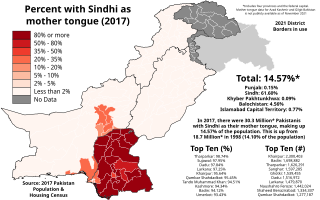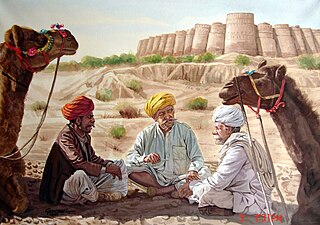Related Research Articles

Sindh is a province of Pakistan. Located in the southeastern region of the country, Sindh is the third-largest province of Pakistan by land area and the second-largest province by population after Punjab. It is bordered by the Pakistani provinces of Balochistan to the west and north-west and Punjab to the north. It shares an International border with the Indian states of Gujarat and Rajasthan to the east; it is also bounded by the Arabian Sea to the south. Sindh's landscape consists mostly of alluvial plains flanking the Indus River, the Thar Desert of Sindh in the eastern portion of the province along the international border with India, and the Kirthar Mountains in the western portion of the province.

Pakistan is a multilingual country with over 70 languages spoken as first languages. The majority of Pakistan's languages belong to the Indo-Iranian group of the Indo-European language family.

Sindhi is an Indo-Aryan language spoken by about 30 million people in the Pakistani province of Sindh, where it has official status. It is also spoken by a further 1.7 million people in India, where it is a scheduled language, without any state-level official status. The main writing system is the Perso-Arabic script, which accounts for the majority of the Sindhi literature and is the only one currently used in Pakistan. In India, both the Perso-Arabic script and Devanagari are used.

Saraiki is an Indo-Aryan language of the Lahnda group, spoken by around 28 million people primarily in the south-western half of the province of Punjab in Pakistan. It was previously known as Multani, after its main dialect.

Kutchi or Kachhi is an Indo-Aryan language spoken in the Kutch region of Gujarat, and some parts of Rajasthan, India and Sindh region of Pakistan.

The Northern Indo-Aryan languages, also known as Pahāḍi languages, are a proposed group of Indo-Aryan languages spoken in the lower ranges of the Himalayas, from Nepal in the east, through the Indian states of Jammu and Kashmir, Uttarakhand, Himachal Pradesh and Punjab was coined by G. A. Grierson.
The Kalhora or Kalhora Abbasi is a Sindhi Sammat clan in Sindh, Pakistan.
The Lasis are a Sindhi ethnic community or group of Sindhi tribes in Balochistan, Pakistan. They form 4.56% of the total population of the province as of 2017, and are the predominant group in the lowlands of former princely state of Lasbela. Now divided into two districts of Balochistan i.e. Lasbela and Hub, some area is in Gwadar district called Ormara. Lasis are also called as Jamote, a term used in Kalat and Kachhi regions, They occupy a high social position and have traditionally been engaged as agricultural landlords. They speak the Lasi dialect of Sindhi Language. Although social stratification is found in individual tribes, there is no social hierarchy or rigid tribal structure. The Lasis are assumed to be related to Jats.
Lahnda, also known as Lahndi or Western Punjabi, is a group of north-western Indo-Aryan language varieties spoken in parts of Pakistan and India. It is defined in the ISO 639 standard as a "macrolanguage" or as a "series of dialects" by other authors. Its validity as a genetic grouping is not certain. The terms "Lahnda" and "Western Punjabi" are exonyms employed by linguists, and are not used by the speakers themselves.

Upper Sind Frontier District was a district of the Bombay Presidency during British Rule in colonial India. The district was the northernmost portion of Sind and lay between 27°56' and 28° 27' N. and 68° and 69° 44' E, with an area of 2,621 square miles (6,790 km2). It was bounded on the north and west by the Dera Ghazi Khan District of the Punjab and by Baluchistan; on the south by Sukkur District; and on the east by the river Indus.
The Balochs of Sindh,, is a community of Sindhi-speaking Baloch tribes living throughout the Sindh province of Pakistan.

The Saraikis, are an Indo-Aryan ethnolinguistic group native to the central Pakistan. They are multi-ethnic in origin and speak the Saraiki language.

Jaḍgālī is an Indo-Aryan language spoken by the Jadgal, an ethno-linguistic group of Pakistan and Iran also spoken by few hundreds in Oman. It is one of only two Indo-Aryan languages found on the Iranian plateau. It is a dialect of Sindhi language most closely related to Lasi.
The Amils are a Sindhi Hindu sub-group of Lohana. The word "Amil" has its origin in the Persian word "amal". Amils used to work in Administration in Government services.

Thaḷī is a Western Punjabi dialect spoken in parts of the Pakistani provinces of Punjab and Khyber Pakhtunkhwa. It is classified by some linguists as a northern dialect of Saraiki, although it has also been described as transitional between Multani and Shahpuri Punjabi. Its name derives from the Thal Desert.
Jatki, Jadgali, and other related terms have sometimes been used to refer to one or another of the Indo-Aryan languages spoken in Balochistan and neighbouring parts of Sindh and Punjab.

Lasi, or Lassi, also called Kohistani is a dialect of the Sindhi language spoken on the western frontier of Sindh and Balochistan in Pakistan. It is spoken by the Sindhi Lasi people of Lasbela, Hub and Gwadar in Balochistan, and Lasi is also spoken in the Kohistan region of Karachi, Thatta and Jamshoro districts of Sindh.
Lari is a dialect of the Sindhi language, which is spoken by the people living in "Laar" region of Sindh, and the dialect of this region is called "Lari". The term Lari is also used for anything which is related to Laar region, like people, food, rituals, traditions, dress etc. The areas along the Indus River and its estuary are called "Laar". Laar means the sloping or lower part, which seems to go with the sea. In Laar, From Badin, Tando Bago, Bulri Sharif, Sujawal, Thatta and Karachi parts are included in Laar. The local dialect is called Lari dialect. Shah Abdul Latif's Risalo, Shah Karim's book, etc. are written in this dialect.
The Sindhis of Balochistan are an indigenous Sindhi population living in Balochistan, Pakistan.
Thareli is a dialect of the Sindhi language, spoken in north eastern Thar Desert of Sindh.
References
- ↑ Stack, George (2017). Abbasi, Prof. Mohsin; Rizvi, Ms. Parsa; Hussain, Dr. Fahmida (eds.). A Dictionary - Sindhi and English (January 2017 ed.). Hyderabad, Sindh: Sindhi Language Authority. p. 603.
- ↑ "سرائي | Sindhi Dictionary". dic.sindhila.edu.pk (in Sindhi). Sindhi Language Authority.
سري جو رهاڪو
- ↑ Austin, Peter (2008). One thousand languages: living, endangered, and lost. Berkeley (Calif.): University of California press. ISBN 978-0-520-25560-9.
Sindhi has six major dialects: Siraiki (Seraiki), Vicholi, Lari, Lasi, Thari (Thareli) and Katchhi (Kachchhi).
- ↑ Masica, Colin P. (1993). The Indo-Aryan languages. Cambridge language surveys. Cambridge University Press (1. paperback ed.). Cambridge: Cambridge University Press. ISBN 978-0-521-23420-7.
- ↑ Handbook of comparative and historical Indo-European linguistics ; Volume 1. Berlin Boston: De Gruyter Mouton. 2017. p. 433. ISBN 9783110393248.
The five major dialects of Sindhi are Vicholi, Lari, Lasi, Thari, and Kachhi. Four dialects are spoken within the borders of Sindh itself. Siraiki, in Upper Sindh, is not to be confused with the Punjabi language of the same name. Vicholi, considered the standard dialect, is spoken in central Sindh, while Lari is the dialect in southern Sindh. Lasi is spoken on the western frontier of Sindh and in Balochistan. The Sindhi spoken in the Thar desert of the Jaisalmer district of Rajasthan is called Thari. In Gujarat, Kachhi is spoken along the Rann of Kutch and in the Kathiawar peninsula.
- ↑ "Linguistic Survey of India". dsal.uchicago.edu. Retrieved 2024-01-24.
In Sindhī, the word siru means 'head.' From it is derived sirō, the extremity of anything, and, hence, the upper part of Sindh, from the northern frontier down to, say, the 27th degree of north latitude, about midway between Larkana and Sehwan. From this, again, is derived the adjective sirāikō, of or belonging to Upper Sindh or the Sirō.
- ↑ Simpson, Andrew (2007). Language and national identity in Asia. Oxford: Oxford University Press. p. 114. ISBN 9780199226481.
Siraiki' is a Sindhi-derived term meaning 'northern speech', hence its confusing earlier use as the name of the northern dialect of Sindhi, now usually termed Siroli.